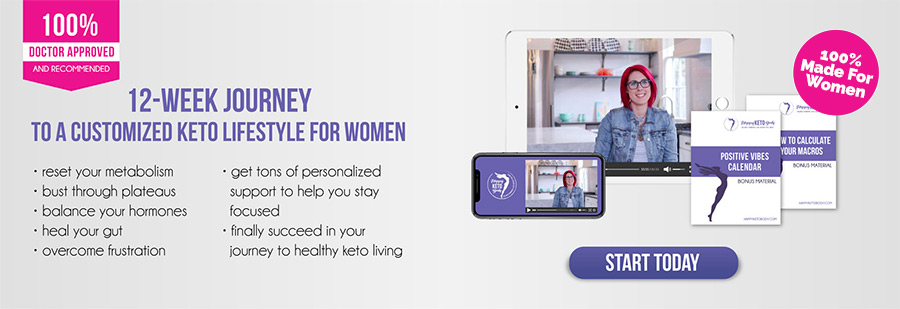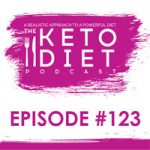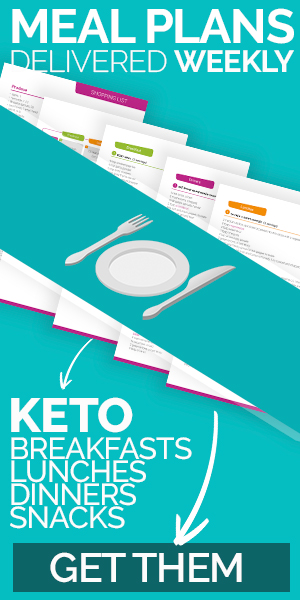I want...
The Keto Diet Podcast Ep. #037: Fasting For Women
June 11, 2017 By
Leanne Vogel

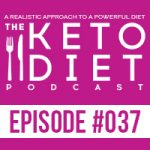 December 7, 2018
December 7, 2018
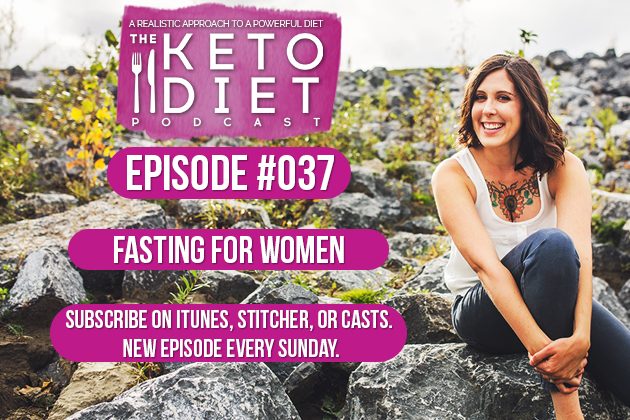
Interview with Megan Ramos, Program Director for the Intensive Dietary Management Program, chatting about which liquids will spike insulin during a fast, body fat and its role in intermittent fasting, how to listen to your body while practicing intermittent fasting, and tips to get you started with your intermittent fasting practice.
For podcast transcript, scroll down.
Show Notes & Links
- Feel awesome on your keto diet with The Keto Bundle
- Get my free 7-day keto meal plan
- Subscribe on iTunes or your favorite podcast app
- Keto Summit registration is free
- More from Megan at Intensive Dietary Management
- Listen to: fasting podcast episode with Dr. Jason Fung
Timestamp
- Fasting and its impact on sex hormones (19:39)
- Signs that fasting isn’t working with your body (28:45)
- Timing intermittent fasting with your cycle (39:08)
Partners of The Keto Diet Podcast

Boost your keto salads with Primal Kitchen dairy-free, low-carb salad dressings. Use Primal Kitchen coupon code FAT for 15% off all Primal Kitchen goods.

Thrive Market 35% savings – get an instant 35% off your favorite premium organic products. All you have to do is enter your email address, and the discount will be applied to your cart! *US only

100% grass-fed & finished FERMENTED beef sticks with 1 billion naturally-occurring, gut-healing probiotics! Go to paleovalley.com for 20% off.
Transcript
Leanne Vogel: You’re listening to episode number 37 of The Keto Diet Podcast. Today we’re chatting about everything to do with fasting for women, including your hormone concerns, timing fasting with your menstrual cycle, adjustments when you’re in menopause or perimenopause, as well as the problems that women will run into while intermittent fasting and so much more so stay tuned.
Hey, I’m Leanne from healthfulpursuit.com and this is The Keto Diet Podcast where we’re busting through the restrictive mentality of a traditional ketogenic diet to uncover the life you crave. What’s keto? Keto is a low-carb, high-fat diet where we’re switching from a sugar burning state to becoming fat burning machines. All listeners of the podcast receive a free seven-day keto meal plan complete with a shopping list and everything you need to chow down on keto for seven whole days. Download your free copy at healthfulpursuit.com/ketomeal. The link will also be in the show notes for today’s episode. Perfect if your daily keto meals have become a bit lackluster, if you’re new to keto and a bit lost when it comes to eating what and how much, or thrive on being guided on what to do and when to do it. Again, that’s healthfulpursuit.com/ketomeal. Let’s get this party started.
Hey, guys. The show notes and full transcript for today’s episode including all of the things we chat about that require links in order for you to dig deeper into things can be found at healthfulpursuit.com/podcast/e37. The transcript is added to the post about three to five days following the initial air date of this episode. Let’s hear from one of our awesome partners.
The show is partnered up with Paleovalley, the makers of the only 100% grass-fed and finished fermented beef stick. Each stick contains one billion probiotic CFUs. We all know how important fermented foods are to the health of our gut and the strength of our immune system, especially during cold and flu season as well as boosting our energy throughout the winter months. Chowing down on Paleovalley’s fermented beef sticks provides your body with all of the beneficial bacteria it loves in one convenient little beef stick. Their gut friendly sticks are gluten-free, soy-free, dairy-free, GMO-free, freaky chemical, additive, dye, and preservative-free as well as being 100% free from carbs and sugar and made with the highest quality ingredients. Exclusive to listeners of this show, receive instant savings of 20% off Paleovalley fermented beef stick snacks by going to paleovalley.com/keto. If your jaw is just tired thinking about beef jerky, it’s worth noting that these tasty treats are not tough at all but moist with a little snap. The summer sausage flavor even tastes like those hickory summer sausages but without the gunk. Seriously delicious. Again, that’s paleovalley.com/keto for an instant 20% off savings.
Leanne Vogel: If you have an idea for a podcast episode or you want to submit praise over and above the review, which you can leave by going to healthfulpursuit.com/review, you can reach me at info@ketodietpodcast.com.
We have two announcements this week, really quick. The first one is that the Keto Summit is back again for a very limited time. The Summit brings together over 35 of the world’s best researchers and practitioners. I was interviewed too to discuss all of the newest science and techniques that are helping people lose weight, boost their energy, and even reverse neurological diseases using a ketogenic diet. This online event is 100% free to watch for three days only. I urge you not to miss this. I got it last time it was out and the recordings blew my mind. It took me forever to go through all of them because there was just so much information. It’s something that you and your family will definitely appreciate. In fact, Kevin listened to many of them. That’s around the time that he was inspired to try a ketogenic diet. It covers every topic from cancer to weight loss to brain health and aging and all with a focus on the ketogenic diet. Head on over to healthfulpursuit.com/summit to register for free.
The second thing is that if you haven’t already left a review for the podcast, I would really, really, really love if you took just like two minutes to leave a review. It takes about two minutes. You can leave a star rating, put in a couple of words. That’s all we need. It just helps more people find the show overall. The podcast is doing really good. The last time I checked, it was number 20 in all health podcasts and number four in health and wellness and fitness. Really cool. I would love to be higher and have more people find out about the ketogenic diet so I really need your help. You can go to healthfulpursuit.com/review and leave a quick review.
Our guest today is Megan and she’s the IDM Program Directory and Clinical Educator. She attended the University of Toronto and developed a strong interest in preventative medicine. She has worked alongside Dr. Fung since 2003 and was the first IDM guinea pig. Our interview today is all about fasting for women and talking about the women in the Intense Dietary Management program and what Megan has seen within the practice.
A couple of things I want to note before we cut over to the interview, the first is that you need to listen. She says a bunch of times that you need to take baby steps when it comes toward developing a fasting practice. Just in case you missed that a bunch of times throughout the recording, I just want to remind you right here and then to kind of set the stage that this is a baby step process. If you’ve never tried fasting, or if you’re even frustrated with fasting and you’re thinking that it might not be right for you, it might be that you’re pushing yourself too hard and it might be that you need to kind of take a step back, listen to this episode. You could even listen to the episode that I did with Dr. Jason Fung, her colleague. It was episode number four called Fasting Versus Calorie Counting on this podcast. You can either access that episode by going to healthfulpursuit.com/podcast/e4 or just head on over to however you’re listening to this on whatever podcast application and look for episode four and it will be in there. Just surround yourself with more fasting information so that you can make an educated choice toward your own health.
With that said, let’s cut over to the interview.
Hey, Megan. How’s it going?
Megan Ramos: Hi, Leanne. It’s going pretty well today. It’s finally summertime here in Toronto. How are you doing?
Leanne Vogel: It’s summer here in Calgary. It’s like 28 degrees today. I’m amazed.
Megan Ramos: It’s not that here yet, but this weekend finally. Toronto’s been under monsoon rains for the last few months so we’re looking forward to the really hot weather this weekend.
Leanne Vogel: Yeah, I was just in Toronto last week and it was super windy and really rainy so as long as it’s not windy and rainy, I think you’re doing pretty good. Every time I’ve been there in the last three months, it’s been windy and rainy.
Megan Ramos: Yeah, the last three months has stunk. We’ll have to have you back in July or August.
Leanne Vogel: I like that plan.
For listeners that may not be familiar with your work, why don’t you start off by telling us a little bit about yourself?
Megan Ramos: Well, my name is Megan Ramos. I’m a clinical researcher. I’ve worked with Dr. Jason Fung for the last 18 years. He was barely a doctor and I was barely able to drive. I was a research student assigned to him. Dr. Fung is a kidney specialist, as many people know, so most of my research is focused in kidney disease, but the majority of my study patients have kidney disease because of diabetes. As the diabetes gets worse, their kidney disease gets worse and there’s nothing that we can do about it.
I was getting disheartened watching my patients die from diabetes, not feeling like I could help them, and Dr. Fung also felt the same way. Then I also had my own issues in my mid-20s. When I was younger, nobody was really concerned about my health despite me having some complications. I was 12 when I had fatty liver, 14 when I was diagnosed with polycystic ovarian syndrome, but I was classified as underweight. Nobody cared about my body composition though. In hindsight, I know I was a skinny little sack of fat. Because the number on the scale didn’t reflect my bone mass and my muscle mass and how much body fat I had and the number on the scale was low, nobody was really concerned and they just said I’d grow out of it. In my mid-20s, I became just obese. That’s when I was diagnosed with diabetes.
Dr. Fung, at this point, he was already researching a little bit about fasting and I knew that. I went to him open minded, grasping at straws. I wasn’t going to die from diabetes. I was willing to try anything. When he talked to me I sort of felt like the biggest buffoon on the planet because everything he said just made perfect sense and everything that we had ever recommended to patients all of a sudden just didn’t make sense at all. I jumped in and I had tremendous success… lost 80 pounds. I’ve kept it off for five years. My hemoglobin A1c is 4.5. There’s no question about my fertility later on in life. All my abdominal ultrasounds, there’s no poly-cystic ovarian syndrome. I have a really clear liver.
After my experience, we had a lot of patients see my transformation and they say, “Megan, we want to do whatever it is that you’re doing. We don’t care.” They saw me come back to life. We were talking with Jason and we decided to give it a go with a few patients once we had gathered some support from our colleagues. In 2014, Jason Fung and I co-founded the Intensive Dietary Management Program in Scarborough, Ontario, which is a burrow of Toronto. We’re in Toronto, Canada. In our clinic, we primarily focus on metabolic syndrome and weight loss and treating that through intermittent fasting and other lifestyle modifications such as a low-carb, moderate-protein diet, but there’s a high emphasis on the intermittent fasting.
Then we also have a long distance program where we can reach out and help people from other countries, provide them with the same fasting education that our in-office patients get. With an Intensive Dietary Management long-distance program, we’re unable to monitor our participants medically because they’re outside of our jurisdiction, but we are able to help them from a nutritional aspect and a fasting aspect. That’s been really great. My in-laws are American and their insurance is just horrendous and just sort of the fear and anxiety over medical bills so we’re really happy to help people out abroad. We’re really spoiled here in Toronto, but even we have a lot of people here that need to be helped despite the great quality of our healthcare system.
It’s been really rewarding. The Intensive Dietary Management Program, we actually just celebrated our fourth year anniversary as an official program on Monday this week. We’re going strong. Both Jason and I were pretty sure someone was going to try to shut us down within four months so we’re really proud to be at four years and we’re going strong.
That’s me. I provide the clinical education and counseling and support for our patients, both in office and online. We have a new men’s weight loss program too that is run by a man named Angel Ramos and we have a naturopath who works with us, Nadia Pateguana, and then of course Dr. Jason Fung. We’re expanding. We’re growing slowly but surely.
Leanne Vogel: Solid team. Sounds like you’ve got your stuff together. That’s awesome and really hard to do. Congratulations on that anniversary. As a business owner too, you have to put a lot of the good people in all the good roles and it’s hard, especially with the work that you’re doing, to keep it rocking. Congratulations. That’s awesome.
Megan Ramos: Thank you. I think we have a perfect team. Hopefully, we can grow it more in the future.
Leanne Vogel: Yeah, you bet.
A couple of questions. First off, where can people find more information about the long distance program?
Megan Ramos: If you go to our website, which is intensivedietarymanagement.com, on the home screen, there’s a subtitle that says join. If you click on join, you’ll see the Intensive Dietary Management Long Distance Program. You can reach out to us. You can reach out to us via email too at info@idmprogram.com as well. We’re happy to answer any questions that you might have about our program.
Leanne Vogel: Beautiful. For people that may not know what fasting is, do you want to go quickly through what you consider fasting and maybe a couple of its benefits?
Megan Ramos: What we consider fasting is sort of abstaining from items that cause an insulin response in the body for a certain period of time. Some of our patients will do 18 hours of fasting or 16 hours of fasting every day, so they’re eating in eight or six-hour eating periods or eating windows. Some of them do intermittent fasting, 24, 36 hours three times a week. Some of our patients will do more prolonged periods of fasting anywhere from three to 30 days. The longest someone’s fasted for in our program was 31 days and, of course, under tight medical supervision from Dr. Fung.
During the fasting period most of our patients are looking to treat metabolic syndrome. There are certain fluids that we permit and these fluids, we consider them to be non-insulinogenic fluids. These are fluids that don’t raise our insulin levels. That’s sort of our definition of fasting in the IDM program, as you want to sort of resist consuming anything during this period that’s going to raise your insulin levels any higher. Metabolic syndrome, it’s not as insulin resistant. Insulin resistance means you have a very high level of insulin in the body. We don’t want to add any more fuel to the fire.
On our fasting days, there are certain fluids that our patients consume such as water, homemade bone broth, tea or coffee with no sweeteners in them, maybe a splash of fat if they do. Fat’s not very insulinogenic at all. We have these very low insulinogenic fluids that the patient can consume. An idea with fasting is that you empty your leftover food from your refrigerator – your internal refrigerator. I always tell the patients to think of their body as that internal refrigerator. When they’re fasting, they’re feasting off of that extra birthday cake slice that they had in 1997 and that extra half a pizza that they ate in 2002 that their body didn’t need the extra fuel from that day. It stored the extra fuel in their refrigerator to be feasted on later, but we never gave our body a chance to feast on all of the leftovers in our refrigerator. We tell the patients that when you’re fasting, you’re clearing out your internal refrigerator because all this unwanted stored fat, that’s just leftover fuel from previous meals that you never had a chance to clear out of your system. We want to clear out the system when we fast. As you do that, you actually lower the insulin levels too. On fasting days, we want to prevent adding more insulin to the system and we can actually reduce the insulin in the system as well. That’s one of the biggest benefits of fasting.
Fasting really helps regulate you hormonally, particularly from an insulin standpoint. Having toxic levels of insulin can put you at high risk of diabetes, cardiovascular disease, so we really want to help lower those insulin levels down. The primary benefit of fasting is hormonal regulation. By decreasing the insulin level, you promote insulin sensitivity in the body. Insulin sensitivity means your cells start to like your own insulin again because they’re not overwhelmed, they’re bombarded by it.
I always talk about patients’ insulin resistance. I joke and say that I developed Adele resistance after her song Hello came out. I was so excited for Adele to have her comeback CD or album and that song, Hello, I loved it at first but then it was overplayed and I developed Adele resistance. But they stopped playing it as often and now when that song comes on, I like it again and I no longer loathe the sound of this woman’s voice and I don’t want to scream, “Good bye,” every time she says hello. I’ve developed Adele sensitivity again.
We talk to the patients about how when you stop bombarding and overwhelming your system with insulin and you’re able to regulate your insulin levels and bring them down, your cells start to utilize it effectively when it’s produced again. This allows for increased movement of glucose into the cells, which promotes energy. A lot of people who are overweight or have metabolic issues, they always feel like they’re dragging their feet because even if their cells need energy, the cells are not able to get that energy because of the insulin resistance. This is why people with excess weight or metabolic syndrome are always so tired all of the time. Even if their cells are screaming for it, they’re not getting it because of the toxic level of insulin in the body. When you regulate the insulin levels, you get a better flow of energy into the cells, which fuels you and makes you more energetic as a result.
People say often they feel like they’ve come back to life. It promotes better mental clarity too, which I’d have to say is sort of our number two feedback from patients. Number one we hear from patients the most is their increased energy. Number two is their increased mental clarity and better sleep. Those are sort of the top three things we hear as feedback from our patients.
Leanne Vogel: That’s awesome and something I experience too with fasting.
More on my interview with Megan Ramos after this message from one of our podcast partners.
Keto salads, they’re a staple in our house. Great for when you’re in a rush, need to boost your fat intake. Salads can hold a lot of fat in them and still taste great or give you that volume in your belly that you don’t always get from standard keto food. Let’s talk dressings for a sec. Sure, you can make your own and they’ll probably taste great but sometimes making your own dressings takes up time, requires ingredients on hand, and just isn’t practical. Enter Primal Kitchen’s line of avocado oil based salad dressings. They’re keto, packed with natural beneficial fats, double as a marinade for your favorite proteins, are nutrient dense with ingredients like avocado oil, oil of oregano, and apple cider vinegar. Plus, they’re always free from dairy, gluten, grain, refined sugar, and soy. Choose your favorite like Honey Mustard, Greek Vinaigrette, Green Goddess, Caesar, or Ranch dressing. Again, they’re all keto, all dairy-free, and all delicious. Try a bottle or five by going to healthfulpursuit.com/primal and using the coupon code “FAT” for 15% off your entire order. Again, that’s “FAT”, all in caps, no spaces, for 15% off at healthfulpursuit.com/primal.
Leanne Vogel: Your analogies are great so thanks for that because that really brings it home for a lot of people. With insulin and you said its impact on hormones, let’s chat a little bit about women’s hormones and fasting because women can maybe run into issues and I think when I was intermittent fasting, the mistake that I made and Jason, when he came on the podcast a couple of months ago, he was talking about the fact that when women fast usually, or men too, when people fast, sometimes they not only fast but they also reduce their calories and they’re trying to manipulate their calories and also fast at the same time. I think that’s why I had so many issues with fasting when I first got started is I was trying to do both strategies, which he was like, “Don’t do that.” Then I started not doing that and I can fast a lot easier. Are there other things specifically for women when it comes to fasting? You mentioned insulin, hormones. By reducing your insulin, are you helping your sex hormones too or not?
Megan Ramos: That is something we commonly hear back from women. They found their libido again. It’s funny like, “At 70 years old, we never thought that we would be all that interested again.” It does have a positive effect at sort of all stages of our life. We do hear increased libido, improved menstruation cycles. Because of estrogen, we have sort of that extra fat-trapping hormone that our male counterparts don’t have to deal with so weight loss is not as rapid.
I will say the majority of patients in our program are female, 70% at least are female in all stages of life. They’ve only ever reported positive feedback. For younger women, when you start fasting, it can cause some irregulation with your menstrual cycle for the first couple of months, and then things regulate beautifully. We hear a lot of the time, and I’ve experienced myself, regular periods every 28 days, almost to the exact hour that it’s going to start. Going from seven-day horrendous periods with terrible cramps to two or three day long periods with very moderate, without the cramps, without the cravings. Even women going through menopause or women who are perimenopausal, postmenopausal, I think they sort of feel like they’re doomed and there’s no weight loss for them, but we’ve had a tremendous amount of success. One of the most common remarks that we hear from patients who are particularly postmenopausal is the increase in their sex drive. We also hear this from men, but not as often as we actually hear from women. They always get so excited to share with me. It’s neat to hear from the patients that they found that excitement, that sexual excitement later on in life.
Leanne Vogel: For the women that are in your program, is it fair to say that they’re having these issues like the metabolic conditions and things? If somebody doesn’t have these issues and they’re just wanting to use fasting to better their health, have you seen that in your clinic or it’s just restricted to people that absolutely need fasting in order to heal their bodies?
Megan Ramos: In our clinic, I would say there’s a small percentage of people that are there for preventative measures. The majority of the patients that we deal with are suffering from metabolic syndrome and they have been for a period of time already. That’s from our experience with them. Most of the people, it’s very few people who come and join us for preventative reasons. I can only comment sort of within my social circle from my female peers who have watched my journey and decided to jump on the bandwagon. They have lots of energy, improved concentration, nothing very specific to women in the preventative sense though other than the improved menstruation. I’m 33 so the biggest comment that I’ve gotten from my girlfriends who are doing this more preventatively or out of curiosity because of my experience, women, I have friends who are struggling a little bit with fertility with PCOS, probably poor body compositions but definitely not in dire straits metabolically other than PCOS. It’s helped tremendously with their fertility and just overall energy is the biggest feedback that I get from them and improved menstruation.
Leanne Vogel: If women are having issues with intermittent fasting, what are some issues that you see in your clinic and how do you overcome those issues with intermittent fasting if there are any?
Megan Ramos: There aren’t too many. I’d say the biggest issue lies with women going through menopause and dealing with more so emotional eating when certain hormones are in flux. We find most of our female patients are very disciplined. They know that going through menopause, there’s a tendency to gain a lot of weight and they don’t want that. Even if they do engage in emotional or stress eating at the time, they know that they’re prone to gaining weight, so they usually make better choices. I’d say the majority of our patients are very highly motivated. We don’t really see that much of an issue other than frustration. In office, our groups are co-ed. Online, they’re not always co-ed. In office, we see a lot of frustration. A woman will be doing the same fasting regimen of a man of the same age but the man is losing twice as much weight. These women will say it’s irritating to hear, but I’m losing weight and I’m not supposed to be losing weight at this time in my life but I’m losing weight and I’m grateful for that. Other than frustration from hearing from their male counterparts, I’d say they’re highly motivated to make wiser food choices, which helps preserve all of the good work that they’re doing through their fasting.
Leanne Vogel: I know that there’s a lot of concern and stuff out there about how insulin, or rather how intermittent fasting, can cause stress on the body or raise cortisol, which in turn raises insulin. What are your thoughts on that?
Megan Ramos: Increase in cortisol is virtually negligible and we work with our patients gradually. Nobody comes in on a cookie cutter regimen. We don’t start everybody off on something like seven days of fasting and 24 hours of fasting if that’s not what that person’s body is going to be okay with. We go with listening to the body. We’re really big on listening to the body. Some people don’t like this because they want to be told very specific instructions, but we’re all really individual.
When I was going to do my first fast Jason said, “Why don’t you try seven days? I mean, you’re not on medication. Yeah, your health is kind of crappy, but you’re young. Why don’t you try seven days?” I thought the same thing as him. “All right. I’ll give it a shot. It’s going to suck mentally but I should be able to push through it.” No, I crashed and burned around 18 hours. Through doing blood work, I discovered that I had a bit of leaky gut. I definitely was not absorbing sodium. Despite the amount of salt that I was taking in broth, I was still feeling like garbage. I had to stop at 18 hours for the first couple of weeks because we don’t want to put too much stress on the body. You need to listen to your body and know when enough’s enough and build it up gradually.
Jimmy Moore was the first one to say this, but he says fasting is like a muscle. He’s exactly right. It’s exactly like a muscle. You have to work it up gradually over time. You can’t expect to jump into the gym and do the same training regimen as a bodybuilder who’s been going to the gym for 90 minutes every day for the last ten years. You’re not going to be like that if you’re not someone who’s gone to the gym in the last 10, 20 years. It’s just not your luck. You have to start off within your body’s own limitations. For me, I started at 18 hours and then every other day, I started pushing it a little bit more until I was able to reach 24 hours, and then I hung out there for a while until I could go beyond that 24 hours. Each time I tried to stretch it, it was a little bit more difficult, but you have to do these things gradually so you don’t put too much stress on the body. Everybody starts where their body is capable of starting because we don’t want to induce too much stress on the body at one time.
Leanne Vogel: Yeah, I would imagine if you’re constantly pushing, that’s where you get into the issues with cortisol. If you’re just like, “Nope, I’m going to do the fast. I don’t care,” would that be fair to say just not listening to the body whatsoever that you can run into issues?
Megan Ramos: Oh, yeah. If you’re hell-bent on “I’m going to fast for X number of days” but you’re getting nauseous and dizzy and like you can’t get out of bed, that’s not good. That’s not good at all. You need to call it quits. You have to build up your fasting muscle there.
Leanne Vogel: Well, I guess that answers my next question which was, you mentioned listening to your body and I love that. That’s something we talk about on the podcast all the time. A lot of people were saying, “What’s my body going to tell me if fasting isn’t good for it?” But you just mentioned feeling nauseous, dizzy, you can’t get out of bed. Are there any other signs that somebody should watch for when it’s like, “Okay, girl. Maybe 18 hour fast is good enough for you right now.”
Megan Ramos: Having nausea is sort of the most alarming one, headaches and dizziness. My rule was my fast ends if I don’t feel like I can drive. If I feel like I would be an impaired driver, my fast ends. It’s one thing to have a little bit of tummy discomfort, but if I start to feel nauseous, my fast ends. I can always try again to stretch it out the next time. Nausea, headaches, dizziness, heavy mental fog. If you don’t feel adequate to give a presentation or, again, if you don’t feel safe to drive, or if you would be uncomfortable balancing your checkbook. I don’t know anybody that balances their checkbook nowadays.
Leanne Vogel: What’s a checkbook?
Megan Ramos: Someone asked me for one recently and I had to ask my husband, “Do we have one of those?” I don’t know.
If you’re not able to keep up with your regular day-to-day activities, then that’s when you need to stop your fast and you can always work your way up to doing longer fasts over time.
Leanne Vogel: Wonderful. Let’s chat a little bit about muscle loss and fasting. A lot of women are concerned that if they fast, they’re going to lose muscle. True or not true?
Megan Ramos: Not true if you’ve got plenty of body fat to spare or any body fat to spare. I will give you one of Jason’s famous analogies in our program. If you’re at a cabin in the woods in the dead of winter and you want to make a fire because it’s freezing outside and it’s freezing inside, you have two options. Your first option is to make a fire using a pile of firewood that’s already chopped for you sitting outside the cabin, or you can go get a saw and hack up the sofa that you would be using to sit on in front of that fire and hack up that sofa and use the sofa to build the fire. What would you do? Well, you would use the firewood, right? The sofa’s expensive. Sofas are outrageously priced nowadays. We just moved. I couldn’t believe it.
Leanne Vogel: It’s so true.
Megan Ramos: You wouldn’t use the sofa. They’re expensive. They’re functional. You can sit on them. You can sleep on them. You can eat on them if you’re not fasting. You can do all kinds of things on the sofa. They serve as a purpose. The only purpose of that firewood is to create a fire. It’s not very functional for you otherwise unless you’re a carpenter. I’m sure you could do something wonderful with it. For most of us, we use the firewood for the fire. You’re not going to use the $2500 sofa over the firewood because the sofa is functional. If you have lots of firewood, why would you use the sofa? If you had no firewood and there’s a miserable storm outside and there is no way you are walking and roaming into the woods to cut down some firewood, you might take apart a dining room chair or a side table to make a fire if you were in dire straits.
So muscle is functional like the sofa is functional, the dining room table is functional. It serves a purpose and it’s a more expensive component of your body than excess fuel is. All this unwanted fat that we have in our system is just excess gasoline that our body has stored in jerry cans we call sacks of fat because we weren’t able to use that fuel from our food before we refueled again. We live in a society where we’re going to the gas station every two hours and buying a full tank of gasoline, so that translates into we’re eating every two hours and we’re eating a tremendous amount of carbohydrates, tremendous amounts of fuel, but we’re only driving a few kilometers or a few miles before we refill again a couple of hours later. At the end of the day, we end up with an excess amount of fuel that we’re not using. We end up storing that in our system to be used later on. All this fat is just excess fuel that’s stored in our system. If you have an abundance of jerry cans in your belly to use as fuel, you’re not going to break down your muscle, you’re going to use the jerry cans. The muscle’s important.
You can run into problems if you do really prolonged periods of fasting. I mean, most people who fast for something like 40 to 60 days, they’re going to start to see some protein breakdown, absolutely. If you’re also very low body fat percentage and you jump on one of these longer fasts like going for five or seven days and you’re doing that frequently, then you can see some protein deterioration there because your body doesn’t have any firewood so it’s got to hack up the sofa. It’s got to break down that muscle for fuel during that fasted state. That’s more of a state of starvation. When you do have excess fuel, even if you’re at a very low percentage of body fat and you’re doing more intermittent fasting, as long as you’re eating adequately on your eating days, you’re always going to have a little bit of stored fuel. When you fast, even if you’re at this low body fat percentage, you’re always going to have a couple logs of firewood to burn so you’re going to be able to preserve your muscle, your functional parts of your body. Am I making sense?
Leanne Vogel: That was the best ever. Yes. You’re good at what you do. Yeah, that was perfect. That analogy is so wonderful. I do have a question though about that excess fuel because I find if my body gets too low in fat, I start having issues like hormonally. My body is just like, “Ah. We need more fat.” I guess that excess fuel and body fat, that amount is different for everyone, would you say?
Megan Ramos: It is different for everybody. I mean women who, particularly women, if you don’t have particularly very much body fat and you’re not feeding yourself adequately, you’re going to experience some hormonal shifts like amenorrhea. Your period might stop. You don’t want to be in the fasted state if your body fat’s too low and you’re not adequately fueling yourself. It’s very individual specific. I’ll definitely say there are very few patients in our program that are doing anything that resembles what anybody else is doing. It’s very individualized. It depends on what your body’s composed of and how you are refueling or feeding yourself when you do eat.
Leanne Vogel: If somebody does have amenorrhea or starts to experience amenorrhea while fasting, do you think that they should stop then?
Megan Ramos: I do, absolutely, particularly if you have low body fat, absolutely. Now, we have a lot of women who clearly have a lot of visceral fat and a lot of subcutaneous fat in their midsection. They definitely have a lot of stored fuel. I’d say the majority of them are over 40% body fat. When they first start fasting, it can definitely delay their periods for the first couple of months. Instead of being 28 days, might be 38 days. This isn’t uncommon for the first couple of months of fasting, but they do have a period. It’s just a little delayed. I often get emails from women saying, “Do you think I’m pregnant? We’ve heard about fasting and ketogenic diets increasing fertility. We’re not wanting to be pregnant right now.” I’ll usually say, “Hang tight for a couple of weeks and the period will come.” It usually throws things out of whack for a couple of months and then the period is like the most regular period they’ve ever had in their lives after that.
If you’re experiencing more of a delayed period when you know you have a lot of body fat, always, always, always get checked out by your doctor. We test our patients all the time. They roll their eyes at us. They call us the vampire club because we’re always checking their blood work all of the time. Our poor lab technician, they just refer to her as the vampire now. We’re constantly monitoring our patients. If you know you have a lot of body fat to lose and your menstrual cycle’s off a little bit, I wouldn’t say it’s cause for alarm, but always get checked out. There’s no harm in having a blood test and having an abdominal ultrasound, but that won’t be the way that it is forever. If you’re at a very, very low body fat percentage, you know you don’t have much firewood in your system and your period does stop, lay back on the fasting and really try to increase the fats, increase the calories in your diet, but then increase them from fat on your eating days.
Leanne Vogel: More on my interview with Megan Ramos after this message from one of our podcast partners.I love being Canadian, home of the true north, strong, and free, but gosh, I’m pretty jealous of you all in the US because you get access to Thrive Market while I’m stuck with limited access to the abundance of health foods that you all know and love. We have 14-day shipping and everything’s really expensive and forget about free shipping. That’s always out of the question. For all my pals south of the border, my friends at Thrive Market are offering you 35% off your first box of groceries plus free shipping and a 30-day trial so you can reorder your favorites a couple of weeks down the road. Imagine spending only $9.95 as opposed to the $20.99 on raw cacao powder or $15.65 as opposed to $24.99 on MCT oil if you go to a retail store. On top of their everyday wholesale prices, the extra 35% off your first box of organic and non-GMO products plus free shipping is going to make a regular $100 grocery run into about a $50, maybe $75 Thrive Market order for the same amount of things. You can go to thrivemarket.com/hp to get your instant 35% off and this offer will expire in a couple of weeks. If you’re on the fence about it, the time is now. Again, that’s thrivemarket.com/hp to get your instant 35% off and this offer is available to new Thrive Market customers only and people in the US. Wah wah.
Leanne Vogel: What about for women specifically with their cycle, do you find that there are periods in a woman’s cycle where it’s just more difficult to fast than others? Like the second phase usually people experience more physical hunger and dealing with cravings or mood swings which makes, I would imagine, intermittent fasting a little more difficult. Have you seen that in your practice?
Megan Ramos: It’s always difficult at first and for those patients, I say never fast during that week or during that time. Instead of indulging on the carb foods, indulge on the fatty foods. Embrace that bacon. Go wild with the eggs. Really embrace the fatty foods, the 90% dark chocolate. Enjoy them. It’s about seeking comfort in those foods that are good for you and that are really going to help neuroregulate your appetite so the fat. The fat’s the most potent thing at neuroregulating your appetite or the most potent macro for neuroregulating your appetite. I really drive them to focus on the fatty foods. I’d say most women really focus … There’s not a whole lot of fasting going on during that time. There’s a lot of focusing on eating the fatty foods, but within six months, they find that that’s not much of an issue anymore and that they can fast regularly. A lot of women don’t find it to be difficult fasting at all during the entire duration.
I’m somebody who is just a miserable, terrible, cranky person who wouldn’t feel guilty for eating an entire pizza and going to McDonald’s and getting a 20 pack of nuggets. I was just a psychotic lunatic during that time in my cycle. That’s not the case anymore. It’s really weird because you’re emotionally stable all the time. I’m so used to being such a psychotic lunatic for a few days every month and I don’t have that anymore. It’s nice. It’s benefited my relationships, my marriage, my work because for a few days every month, I’m not sort of dormant at work and I’m very productive. It’s nice to have control over your cravings again.
First step is to really focus on the fats and then just let your body progress naturally. We see time and time again that improved mood, ability to fast, no bloating, no weight fluctuations. It’s pretty amazing, actually.
Leanne Vogel: I feel you on that. It’s kind of weird to not have that crazy, psycho time of just feeling always off and horrible. That six-month period that you mentioned where it gets easier to fast during that period, why is that? Is it because you’re more fat adapted? Why does it get better?
Megan Ramos: I think more fat adapted and I think that’s a big, big role. Eating the carbohydrates definitely has a huge effect on our mood and being more fat adapted we know can help alleviate things like depression and improve other psychiatric disorders. I think it’s primarily just sort of becoming fat adapted. I also think it has a lot to do with reducing the insulin levels as well. You know, I was prone to water retention and whatnot, which can help alleviate a lot of the discomfort during that time too.
Leanne Vogel: I guess that answers my next question which was from one of our listeners. They asked, “How do you feel about using intermittent fasting with ketosis together for women?” I guess you’re for that or …
Megan Ramos: Yeah. In our program, we really emphasize fasting. Toronto’s the most cultural diverse city in the world. Over 50% of the population weren’t born here. A lot of our patients come in and they live in large households and they’re trying to establish themselves here in Canada. The money’s not there for them to buy their own special, unique diet so they have to eat what their family is eating, which tends to be more economical carbohydrates. We really placed a large emphasis on fasting and time restricted eating windows in our in office patients. With our in-office patients, we do try to get them to cut back on the portions of the carbohydrates if they’re going to have them. Take less potatoes. Take less fries. Take more salad. If you can’t forgo the potatoes or the rice altogether, take more of the vegetables, more of the broccoli. We do try to scale it back. I’d say most of our in-office patients were able to get to more of a moderate low carbohydrate diet, but there’s socioeconomic factors with our patient population in-office. We really focus on the fasting, and on their eating days it’s not one giant eight hour eating window that they would have. We focus on more time restricted eating windows.
With our long-distance patients though, the majority of our 75% actually, I just did the stats on this the other day, 75.6% of our long-distance patients are female. Most of our long distance patients have already been doing a ketogenic diet coming to us. They just haven’t been able to lose that last … I’d say the majority of them sort of get stuck around the last 20 to 40 pounds, and the ketogenic diet’s just not driving them down to sort of their ideal body composition. We throw in the fasting. Most of them are doing ketogenic diet. I’d say the majority of them are checking their ketones regularly for biofeedback, more so for motivation, to stay away from the carbohydrates and for fasting. That’s one of the bigger reasons why any of our patients would check ketones. We don’t recommend it, actually. Jason doesn’t want people to have to obsess over tracking anything, but a lot of people will check their ketones for a good feedback mechanism, to help keep them motivated.
Most of them follow ketogenic diets. I’d say a few of them track their macros. You know, I’d say if you know you’re eating good quality foods, if you know you’re cooking your vegetables in fat or adding fat to your vegetables and same thing with your protein source that you might be having and you’re not going wild with the protein. I’m 5’1″ and I’ve eaten a 16 ounce filet mignon in my life and that’s going wild with the protein. If you’re not doing that on a regular basis and you’re adding a little bit of fat to it if it’s not a fattier cut, then you’re doing a great diet. There’s no need to really obsess over counting and tracking and restricting certain things.
Our biggest culprits are nuts. We get a lot of patients who struggle with grazing on nuts in between eating windows or throwing in a couple cups of nuts. Nuts like macadamia nuts are not that offensive because their protein content is so low, but we have a lot of patients taking handfuls of almonds and walnuts with each meals, then that’s when we run into issues with that excess protein being converted to glucose and spiking insulin levels through gluconeogenesis because they’re taking those nuts in addition to the other protein sources in their meal as well, which would have been adequate on their own. We don’t restrict nuts, but we really try to educate our patients about the importance of making them parts of their meals rather than having them as a separate entity on their own on their eating days. We really don’t push them to track too much.
I’d say an ideal combination is a ketogenic diet and intermittent fasting. I myself do a ketogenic diet and I’m human. I’m not going to claim to be perfect here. I’ll say I’ll adhere to it 95% of the time. When I first started, I did track my macros to learn a little bit about how my body was responding. I’m a scientist so I love numbers. Where some people can get too carried away with monitoring their own, I get excited about that kind of stuff. I did check it at the beginning. I haven’t checked my macros in a very long time. I check my ketones periodically. They’re fantastic. I just make sure that I’m just having a variety of fats in my diet and then I’m cooking or adding these fats to my vegetables and picking fattier protein sources. I found that it’s worked really well for me.
When I first started fasting, of course I lost a lot of weight and all my biomarkers and my lab test results and my ultrasound results improved a lot, but I didn’t experience that tremendous amount of energy that I would read other people experiencing online. Back when I started fasting, it was still taboo. There was an odd person online blogging about it but there wasn’t that much support. It wasn’t until I switched to a ketogenic diet that I felt that boom in energy. It takes a while to become fat adapted. Even though I was generating a lot of ketones, my body definitely wasn’t using them effectively. By using the combination of the fasting and the ketogenic diet, it took me about six months. Once I became fat adapted or keto adapted, I mean, I was like the Energizer bunny. I never thought I would have that. I always thought I had damaged my body too much. I definitely think a combination of the two is optimal. We see a lot of long-distance patients who are very consistent with their intermittent fasting and who follow a ketogenic diet and they just kick butt left, right, and center. They’re doing phenomenal.
Leanne Vogel: Very cool. That’s awesome. My last question for you is more if somebody listening right now is new to intermittent fasting and they are really inspired by what you just shared, how would they get started and what are some of the first steps that you would recommend that they do?
Megan Ramos: The first step that I usually recommend to people who have no background with intermittent fasting is to just sort of focus on eating in time restricted eating windows. Don’t graze between breakfast and lunch and lunch and dinner and definitely try not to eat after supper as well, so really focus on time-restricted eating windows and really sort of emphasize the fats and reduce the carbohydrates in the diet. Some patients will start off with three time restricted eating windows of about 60 minutes per day and then will go to two 90 minute eating windows a day. Doing it gradually is always a good step. Slow and steady always wins the race. Really cut out grazing and cut out snacking. If there’s any dietary advice I wish I could shout from the top of the CN Tower, it would be don’t snack, don’t snack, don’t snack. Eat at your meal times and make sure you’re eating fatty foods so you’re feeling satiated and wait until your next meal time to eat. Just stop snacking in between. I think that’s the best training you could do for your body to get yourself ready to do some fasting.
Leanne Vogel: Amazing. Great advice. Where can people find more from you? I know you kind of shared some links at the beginning but feel free to share more or the same ones. Where can people find more from you?
Megan Ramos: Well, you can always follow us on social media. I’m working on Twitter. I’m like the computer illiterate millennial on the planet. I married a younger guy so he could teach me how to do this stuff. I’m on Facebook. You can Facebook.com/meganidm. That’s Megan, M-E-G-A-N. There’s no H. You can follow me on Facebook at Megan J Ramos. That’s Megan, J as in Jennifer, and Ramos, R-A-M-O-S. My Twitter handle is the same. That will be a lot more active starting actually next week because that’s when I’m scheduled for a lesson on updating my own internal software and getting with the times. You can always contact me on the Intensive Dietary Management website at intensivedietarymanagement.com. There’s a contact box there and you can always drop a line and the message will come directly to my inbox.
Leanne Vogel: Amazing. I will include all the links that you just shared, many of them on the show notes, which everyone can find at healthfulpursuit.com/podcast/e37. Thanks so much for being on the show today, Megan.
Megan Ramos: Thanks, Leanne. Thanks for having me.
Leanne Vogel: You bet.That does it for another episode of The Keto Diet Podcast. Thanks for listening in. You can follow me on Instagram by searching Healthful Pursuit where you’ll find daily keto eats and other fun things and check out all of my keto supportive programs, bundles, guides, and other cool things over at healthfulpursuit.com/shop and I’ll see you next Sunday. Bye.

I work on finding the best products that have quality ingredients, care about their customers, and have integrity. The brand(s) I’ve shared here are awesome, and I stand behind them 100%. Opinions in this blog post are never ever influenced by the partner. Like, never!
This entry was tagged: eating high-fat, eating keto, eating low-carb, fat-adapted, how eat keto, intermittent fasting, keto basics, keto diet, keto diet book, keto for women, keto life, ketogenic diet, ketogenic for women, ketosis, low-carb paleo, what is keto
Hi! I'm Leanne (RHN FBCS)
a Functional Medicine Practitioner, host of the Healthful Pursuit Podcast, and best-selling author of The Keto Diet & Keto for Women. I want to live in a world where every woman has access to knowledge to better her health.
